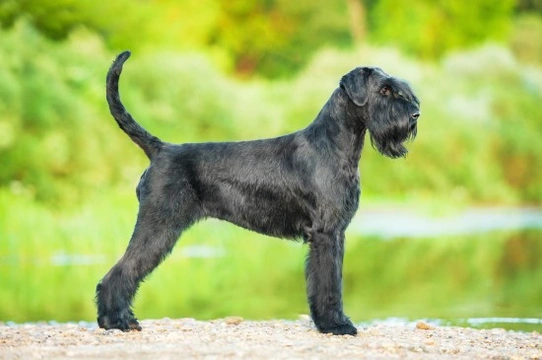
Is a giant Schnauzer the right choice of dog for you?
The giant Schnauzer is, as the name suggests, a very large dog breed, which is the largest of the three variants of the Schnauzer breed. They were developed in Germany in the 17th century, with various breeds including the Great Dane and German pinscher forming part of their history. They are versatile, intelligent working dogs that have historically held a large number of different roles, including guarding homes and farms, droving livestock, and herding. In more modern years, they have also been widely used as police and military dogs, making them one of the most versatile of all of the giant dog breeds.
Tall, noble and distinctive in appearance, the giant Schnauzer is one of the most popular choices of pet among people who love large dogs, and they are one of the most widely seen giant breeds within the UK. If you are wondering if a giant Schnauzer might be the right choice of dog for you, in this article we will cover some of the most frequently asked questions about the breed. Read on to learn more.
What is their temperament like?
The giant Schnauzer is reputed to be a very quiet dog, but one that has strong guarding instincts and is very protective of their families. They can be territorial about their home and garden, and are often wary or suspicious of strangers. They can be aggressive if poorly trained or deliberately trained for aggression, but are eminently biddable with the right management.
They are high energy and rather lively dogs for their size, and have a propensity to become bored easily if they do not have enough to do. They like plenty of entertainment and mental stimulation, and may become destructive if left alone for long periods of time.
How much exercise do they need?
The giant Schnauzer is a lively dog with a bright, outgoing outlook and as such, requires plenty of exercise. They are active and like to spend plenty of time outside, and will soon become bored if kept within a sedentary lifestyle. Variety is important for the giant Schnauzer, and they are prone to becoming bored with too much repetition.
They require at least two long walks per day, and also plenty of opportunity to run around and be able to stretch their legs off the lead.
Are they easy to train?
The breed as a whole is intelligent and versatile, and they are able to turn their paws to all sorts of skills and abilities. They are bright enough to be able to learn and execute a wide range of commands, and are an excellent choice for taking part in various different types of canine sports.
They require an experienced, confident trainer who knows how to keep things interesting, and that can manage the dog’s potential propensity to stubbornness. They benefit from clear boundaries and positive reinforcement training, and an interesting, varied programme of ongoing development.
Do they get on well with other animals?
The giant Schnauzer is one breed in particular that requires good early socialisation to teach them about appropriate behaviour with other dogs, and once this is achieved, will be able to play happily with other dogs that they meet. They can be prone to being rather dominant, but are rarely aggressive or ill-mannered when well trained.
They can potentially share their home with cats if introduced when young and taught to respect and not chase the cat, but they do have a relatively strong prey drive, and may be prone to chasing other cats and small wildlife when outside of the home.
Do they get on well with children?
The breed as a whole is reputed to be excellent with children, being calm, tolerant and affectionate. They are very forgiving of minor mistakes in handling made by their immediate family, and will often be very protective over the smaller members of their human pack. They require introductions to be made to any visiting children that may come to the home, due to their potential suspicion of strangers, and should always be supervised when around children that are not a part of their immediate family.
Children too should of course be taught to respect the dog and handle them correctly, and most importantly, not to try to ride the dog, however large it may be!
What type of home do they need?
As a large dog, the giant Schnauzer requires a reasonably large home, and a big enough enclosed garden for them to be able to go out and stretch their legs in between walks. They benefit from being involved in active family life, and do not like being left alone for long periods of time, and so would not be well suited to a family where everyone is out at work for large parts of the day.



